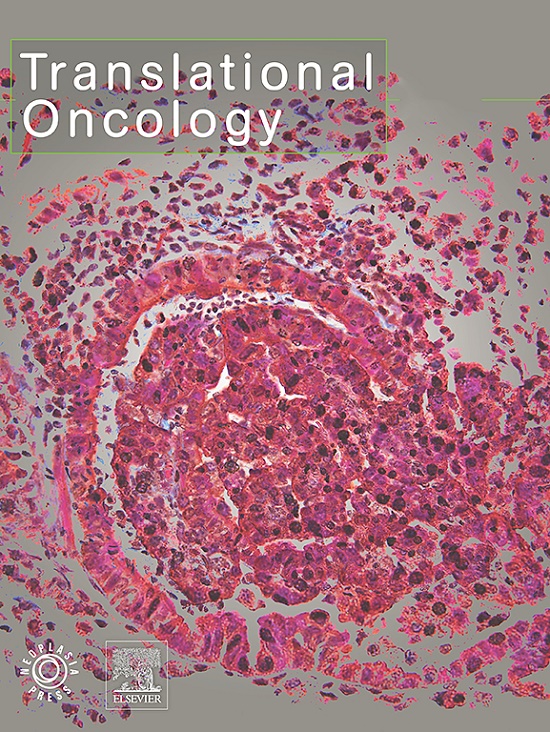基于mri的深度学习和放射组学预测PD-1抑制剂联合诱导化疗在晚期鼻咽癌中的疗效:一项前瞻性队列研究。
IF 5
2区 医学
Q2 Medicine
引用次数: 0
摘要
背景:越来越多的鼻咽癌(NPC)患者受益于免疫治疗和化疗作为诱导治疗。目前,尚无可靠的方法来评估该方案的疗效,这阻碍了后续护理的知情决策。目的:建立并评价基于深度学习特征(DLFs)和放射学特征预测程序性死亡-1 (PD-1)抑制剂联合GP(吉西他滨和顺铂)诱导化疗疗效的模型。方法:入选99例晚期鼻咽癌患者,按7:3的比例随机分为训练组和测试组。通过MRI扫描,DLFs和常规放射学特征恢复。采用随机森林算法识别最有价值的特征。然后利用这些放射学特征和dlf建立预测模型,以确定PD-1抑制剂联合GP化疗的有效性。采用受试者工作特征(ROC)曲线分析、曲线下面积(AUC)、准确度(ACC)和负预测值(NPV)评估模型的性能。结果:构建了21个预测模型。结合放射组学特征和DLFs的Tf_Radiomics+Resnet101模型表现出最好的性能。模型在训练集和测试集的AUC、ACC和NPV值分别为0.936 (95%CI: 0.827-1.0)、0.9和0.923。结论:基于MRI和Resnet101深度学习的Tf_Radiomics+Resnet101模型能够较好地预测PD-1抑制剂联合GP治疗晚期鼻咽癌的临床完全缓解(cCR)疗效。该模型可显著提高晚期鼻咽癌患者的治疗管理水平。本文章由计算机程序翻译,如有差异,请以英文原文为准。
MRI-based deep learning and radiomics for predicting the efficacy of PD-1 inhibitor combined with induction chemotherapy in advanced nasopharyngeal carcinoma: A prospective cohort study
Background
An increasing number of nasopharyngeal carcinoma (NPC) patients benefit from immunotherapy with chemotherapy as an induction treatment. Currently, there isn't a reliable method to assess the efficacy of this regimen, which hinders informed decision-making for follow-up care.
Aim
To establish and evaluate a model for predicting the efficacy of programmed death-1 (PD-1) inhibitor combined with GP (gemcitabine and cisplatin) induction chemotherapy based on deep learning features (DLFs) and radiomic features.
Methods
Ninety-nine patients diagnosed with advanced NPC were enrolled and randomly divided into training set and test set in a 7:3 ratio. From MRI scans, DLFs and conventional radiomic characteristics were recovered. The random forest algorithm was employed to identify the most valuable features. A prediction model was then created using these radiomic characteristics and DLFs to determine the effectiveness of PD-1 inhibitor combined with GP chemotherapy. The model's performance was assessed using Receiver Operating Characteristic (ROC) curve analysis, area under the curve (AUC), accuracy (ACC), and negative predictive value (NPV).
Results
Twenty-one prediction models were constructed. The Tf_Radiomics+Resnet101 model, which combines radiomic features and DLFs, demonstrated the best performance. The model's AUC, ACC, and NPV values in the training and test sets were 0.936 (95%CI: 0.827–1.0), 0.9, and 0.923, respectively.
Conclusion
The Tf_Radiomics+Resnet101 model, based on MRI and Resnet101 deep learning, shows a high ability to predict the clinically complete response (cCR) efficacy of PD-1 inhibitor combined with GP in advanced NPC. This model can significantly enhance the treatment management of patients with advanced NPC.
求助全文
通过发布文献求助,成功后即可免费获取论文全文。
去求助
来源期刊

Translational Oncology
ONCOLOGY-
CiteScore
8.40
自引率
2.00%
发文量
314
审稿时长
54 days
期刊介绍:
Translational Oncology publishes the results of novel research investigations which bridge the laboratory and clinical settings including risk assessment, cellular and molecular characterization, prevention, detection, diagnosis and treatment of human cancers with the overall goal of improving the clinical care of oncology patients. Translational Oncology will publish laboratory studies of novel therapeutic interventions as well as clinical trials which evaluate new treatment paradigms for cancer. Peer reviewed manuscript types include Original Reports, Reviews and Editorials.
 求助内容:
求助内容: 应助结果提醒方式:
应助结果提醒方式:


